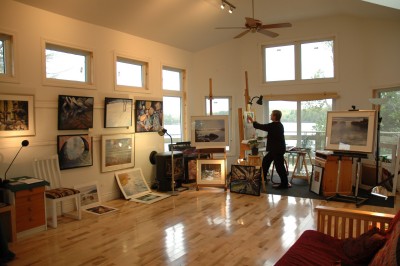
I was reminded of this when I recently visited a picturesque small art gallery north of Ottawa in the Gatineau Hills. Something about one particular picture among the many touched a place in me and I found myself drawn to it. It was a pastel with, to me anyway, a dreamy quality to it. The title was “Afternoon Light at the River”. Nothing dramatic, just water flowing over rocks, but to my mind very powerful. The artist’s name was Aili Kurtis.
Later I was talking to one of the artists at the showing who asked me if I had seen anything I liked. I replied that one particular picture had caught my eye and I wondered about the painter. I was told the artist was local and either Estonian or Finnish. She wasn’t there that day but she had her own website. Shortly afterwards I visited her impressive website, discovered that her parents were Estonian and then contacted her.
Aili was born in Ackulager, Germany, at a displaced persons camp near Hanover. Like many World War Two Baltic refugees, the family landed at Pier 21, Halifax. She grew up in Yellowknife and remembers the town being full of Indians, prospectors, bush plane pilots, adventurers and gamblers. There was only one other Estonian, an RCMP officer.
Aili’s parents told her stories of the art and elegance of Europe and she resolved that someday she would see the outside world. She has certainly done this. Off she went, first to Ontario College of Art in Toronto and later to École des Beaux-Arts and University of Québec in Montréal. Later, her interest in art, philosophy and religion caused her to become a world traveller.
Aili had some interesting jobs before becoming a successful full-time painter. She has been a freelance graphic designer, illustrator, instructor at the Ottawa School of Art, Creative Director of Corel Corp and a courtroom painter for CTV. Her studio is located at Pike Lake about 80 kilometres west of Ottawa. She works with pastels, acrylics and oils.
On her website she writes that her reverence for the land and its natural beauty has inspired her to paint the rhythms of the Canadian landscape. She believes that there is a profound personal bond between the artist, the land and spirit. That is why she chose to paint the natural world that surrounds her. She is currently working on a series of oil paintings named “Shadows and Reflections”.
The artwork and articles on her website show Aili to be a gifted prolific artist as well as talented writer.
For those of you interested in further information, her website is at: www.ailikurtis.com/home.html
She can be reached by telephone at (613) 230-1005 (residence) or (613) 267-3281 (studio).


















